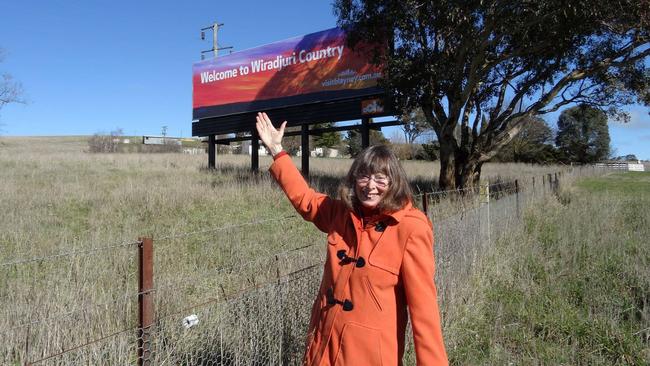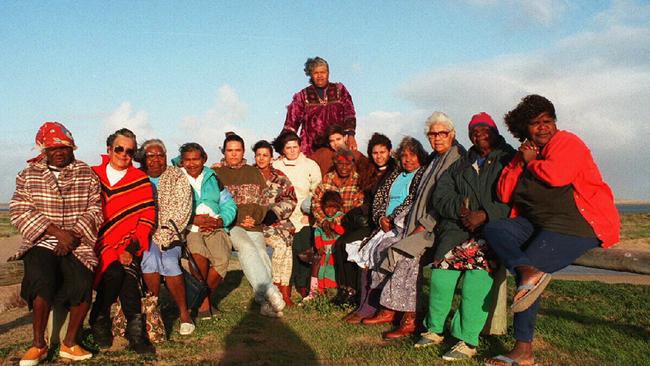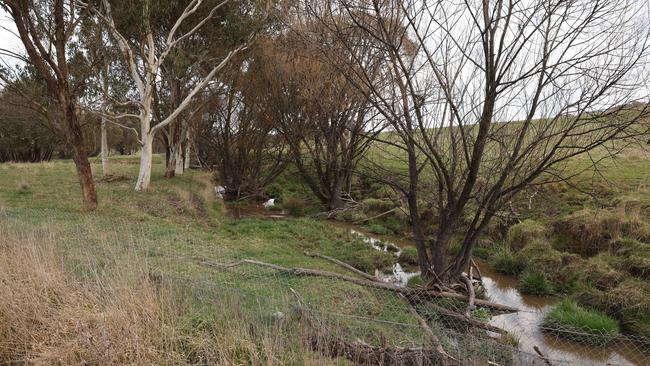Labor kicks a hornet’s nest with the Indigenous Heritage Act
Three decades after the Hindmarsh Island fiction, another secret cultural claim is blocking a crucial project.

Here was federal Labor, less than a year after turning the Indigenous voice into a divisive failure, trying to prove its heart-on-the-sleeve commitment to Aboriginal empowerment. Only, just like its handling of the voice, it will achieve the opposite.
Plibersek has kicked a hornet’s nest by ignoring the most appropriate heritage custodians and making judgments about cultural interpretations that at least are contested and, in the view of some Indigenous people, may have been fabricated.
This controversy has a long way to play out and likely will undermine trust and become another setback for reconciliation, not to mention creating investment uncertainty and more political pain for the Albanese government. The echoes down the decades from Hindmarsh Island are deafening.
The fabrication of secret women’s business to block a proposed bridge to Hindmarsh Island near the mouth of the Murray River in South Australia could easily have gone unexposed. It certainly worked initially; the federal Aboriginal affairs minister at the time, Robert Tickner, used the secret information, sight unseen, to ban the bridge in 1994, giving Indigenous activists a famous victory.
If it had been left at that, perhaps people would still be taking ferries across the Murray to the island, and the marina development reliant on a bridge would have been curtailed. And perhaps the secret women’s business of Hindmarsh Island would have been passed down to generations of Ngarrindjeri women.
But a brave group of Indigenous women stood up. They were intent on standing up for the truth and preventing their Ngarrindjeri culture from being bastardised for quasi-political gain.
Led by Dulcie Wilson and Dorothy Wilson, they called out the hoax in 1995. After I checked and verified their claims and they went public with their dissent, my investigations continued and forced a royal commission that vindicated their stand, confirmed the fabrication and gave a clarion warning to the nation about Indigenous cultural heritage claims.

The bridge was built and opened within years. Then Dulcie, Dorothy and the other truth-tellers of the Ngarrindjeri community went back to their community lives.
Three of their leading lights, Dulcie, Bertha Gollan and Beryl Kropinyeri, have since died. But back on the day we gathered to celebrate the royal commission findings in December 1995 Kropinyeri matter-of-factly summarised what was at stake, and I used the quote on the title page of my book about the saga: “Reconciliation starts with the truth.”
These women experienced considerable trauma and won no benefits from their principled stand. And I wonder now whether it was worth their while because it seems the nation, or at least the Labor politicians, have learned nothing.
Once again, this month, a federal government minister, Plibersek, has banned a project based on contested Indigenous cultural heritage claims. In doing so, she said the reasons must be kept secret.
Regis Resources spent five years on planning, environmental and Indigenous approvals, including winning the assent of the Orange Local Aboriginal Land Council, for the new goldmine, between Bathurst and Orange. Yet at the last minute another Indigenous group convinced the minister to ban the mine’s proposed tailings dam.
Plibersek’s formal statement cited “traditions … disclosed to me privately” that “must remain confidential due to their cultural sensitivity”. So much for transparent government, I guess, but at least Plibersek was told about these traditions, even though her explanation for keeping them secret is thin and convenient.
When it came to the Hindmarsh Island secret women’s business, Tickner decided he could not assess the claims on account of his sex so he had female anthropologist Deane Fergie examine them. You could drive a truck through her emotive, wishy-washy report (and I later did) but Tickner took her word, banned the bridge and became a hero to Indigenous activists and the green left – for a while. Within a year the whole farce caved in on him.
The fabrication was exposed and confirmed in 1995, and it played a role in the downfall of the Keating government at the 1996 election, when Tickner lost his previously safe seat of Hughes in Sydney’s south.
The episode starkly demonstrated that Indigenous cultural heritage claims could be manipulated and weaponised, and that much greater scrutiny and testing were required.
The opposition to the Hindmarsh Island bridge started with wealthy property owners who did not want their view spoiled and was enjoined by environmentalists.
Once all environmental and Indigenous objections had been allayed and the project was approved, one anthropologist told a couple of Indigenous activists: “It would be nice if there was some women’s business.” Within days some leading Ngarrindjeri men were discussing “secret women’s business”.
Yet here we are, nearly three decades on, and the processes are no less opaque and unaccountable. A last-minute, contestable, secret, cultural claim has been used to block a crucial project despite earlier Indigenous heritage assessments clearing the development.
The relevant heritage body, the Orange Local Aboriginal Land Council, surveyed the mine site and raised no objections. But opposition has come from the Bathurst-based Wiradyuri Traditional Owners Central West Aboriginal Corporation, which is not a land council.
One journalist tracked down the organisation this week to a room behind the food court at Charles Sturt University in Bathurst. Apparently a couple of elders were in the room but refused to talk.
When Guardian Australia first reported their objections late last year, they quoted Wiradjuri elder Uncle Bill Allen talking about the proposed mine area. “They’d hold ceremony with the boys that were going to be initiated into men and become warriors. They were brought to that area from all parts of Wiradyuri country. They followed the different songlines that come into that place.”
There may have been further reasons for the objection, but if the focus is on initiation it raises the question of whether Plibersek, as a woman, has been informed about suggested cultural traditions that would be secret men’s business. If Plibersek hasn’t been properly informed this might be Tickner and Hindmarsh Island with a reverse double pike, and it raises more questions about the processes.

The most prominent opponent of the mine project has been artist Nyree Reynolds who has described herself as a “very light-skinned descendant” of a Wiradjuri woman many generations ago, was born on the coast at Wollongong and, until at least 2014, identified as Gamilaraay. Reynolds says she has discovered this Wiradjuri ancestry on her father’s side, but other Wiradjuri leaders say they have never heard of her.
Wiradjuri man and former NSW Aboriginal Land Council chairman Roy Ah-See is one of them, and he is outraged by the decision to block the tailings dam. “My old people would be rolling in their graves if they knew,” he told the News Corp Bush Summit at Orange on Thursday.
Ah-See laments the lost economic opportunity for Indigenous people who need jobs and “empowerment”. On The Kenny Report he told me: “We’ve got an Aboriginal elder, he’s a man who speaks with authority, and he believes that it’s fabricated, that what they’re saying isn’t true at all, and that it makes a mockery of our processes and our old people, and I’ll stand up to protect our old people.”
Opposition Indigenous Australians spokeswoman Jacinta Nampijinpa Price says the authority in this case should be the Orange Local Aboriginal Land Council. “It is the land councils that are the legal entity that make these determinations on behalf of traditional owners,” Nampijinpa Price says.
The reaction from Labor politicians has been unrealistic – they are in denial about what they have unleashed. Plibersek and Anthony Albanese have been trying to downplay the issue, pointing out it is “only” the tailings dam that has been blocked.
Plibersek now says her protection order is all about saving the “headwaters and springs of the Belubula River which are significant to local Wiradjuri traditional owners”. But environmental assessments had already ensured the river was protected and the authorised Indigenous land authority approved the project.
Plibersek and Albanese now say Regis Resources should just relocate its tailings dam.
“They are saying publicly that there’s up to $7bn worth of gold in the ground,” Plibersek says. “If that’s the case, then it’s in their interests to have a look around at alternate sites.”
NSW Premier Chris Minns is suggesting (although pointedly not promising) that a revised development may be fast-tracked. Yet the mining company could go through this process, perhaps spend another year, two years or more adjusting its plan and seeking environmental and Indigenous approval, only to be thwarted by another section 10 claim at minutes to midnight. The message to investors is bleak. They are invited to take their chances on a system that is as clear and predictable as a mudslide.
And all this skirts around the underlying problem that hangs over all developments in all jurisdictions around the country. The assessment of Indigenous heritage and cultural claims is a lucky dip.

It cuts both ways too. You only need to consider the Juukan Gorge debacle in Western Australia, where an indisputably important Indigenous heritage site was destroyed by mining, to understand that.
We need to comprehend the difficulties. Broadly speaking, in Indigenous culture all the land is sacred, so these determinations are about assessing the relative importance of certain locations, and weighing the consequences, costs and benefits of proposed developments. Disagreements between geographic or cultural Indigenous groups are commonplace. Governments need to have sensible, effective and accountable ways to judge claims and weigh competing views.
The cost to the country, especially the resources sector, is immense. Think of resources locked away at Coronation Hill or Jabiluka, and projects delayed and stymied by opaque Indigenous claims such as Santos’s Barossa gas development off the Northern Territory coast.
A range of courts and laws, including native title, come into play. But as for section 10, there is no transparency or accountability and there is no standard process or, apparently, procedural fairness – convince a minister, any old how, and you get your project blocked.
Some ministers are more susceptible to different arguments than others, and some claims strike a better chord. The catch-all cry of cultural secrecy provides the ultimate smokescreen from scrutiny.
In the case of the Blayney goldmine, the section 10 application reportedly was proposed with assistance from the Environmental Defenders Office, which lost federal funding in the Coalition years but had it restored under Albanese. This means taxpayers’ money is used to fund legal action against economic development that benefits the nation, regional economies, Indigenous communities and taxpayers.
Just more national self-harm.
This demonstrates an ongoing mess around Indigenous cultural issues and it exposes the incompetence of the Albanese government in managing them. Plibersek needs to stop keeping secrets and ensure the cultural heritage claims around the goldmine are properly assessed, including by the other Indigenous groups that welcome the development.
The public needs to have confidence that the right decisions have been made. If not, Labor should admit the error, rescind the ban and put in place better processes.
Labor allowed its partisan preoccupations to trash a generational opportunity to entrench local, regional and national Indigenous consultative bodies or voices. Now it needs to find another way to deal honestly and productively with Indigenous leaders to resolve these issues.
The status quo is inadequate. Reconciliation starts with the truth.







Federal Environment Minister Tanya Plibersek would have made herself something of a hero to radical Indigenous activists when she used section 10 of the Indigenous Heritage Act to ban the tailings dam for the proposed Regis Resources goldmine near Blayney in the Central West region of NSW.